5G Impact on Tournaments: Transforming Sports and Gaming Events
Updated On: November 13, 2025 by Aaron Connolly
How 5G Is Transforming Tournaments
5G networks are shaking up competitive gaming. They deliver ultra-low latency and huge bandwidth, knocking down old connectivity barriers.
These upgrades make mobile tournaments, cloud competitions, and interactive viewing feel effortless. Before 5G, none of this really worked well.
Key Advances in 5G Technology
Network slicing stands out as a major breakthrough for tournament organisers. This tech carves out dedicated bandwidth just for gaming, keeping performance stable even with thousands of players.
Mobile operators now roll out gaming-specific network packages. They charge players an extra £5-£11 a month, but in return, gamers get minimum guaranteed speeds and latency below 5 milliseconds.
Edge computing integration puts processing power right near tournament venues. Games run on local servers, not far-off data centres, which slashes connection delays by up to 75%.
The mobile gaming transformation is honestly wild. 5G wipes out the difference between smartphones and gaming PCs, so now you can have console-quality tournaments on your phone.
Check out PUBG Mobile tournaments—they offer £4.8 million prize pools. That’s on par with classic PC competitions.
Why Low Latency Matters for Tournaments
Tournament organisers rely on millisecond-precise timing. In games like VALORANT or Counter-Strike, even a 20-millisecond delay can flip a match.
5G brings latency down to under 5 milliseconds. Compare that to 4G, which usually sits at 30-50 milliseconds.
Players actually notice the difference. Pros say they see 23% fewer “ghost shots”—you know, those frustrating hits that don’t count—when they compete on 5G instead of broadband.
Organisers can now run global competitions without anyone being disadvantaged by geography. Players in remote areas get the same low-lag connections as those near big data centres.
Mobile esports growth is proof of this shift. Asian tournaments now pull in 50 million concurrent viewers on mobile, and 5G keeps streams stable and high-quality, no broadband required.
Role of High-Speed Connectivity in Competitive Settings
Cloud gaming integration lets tournaments run everything on remote servers. Players just need basic devices, since the heavy lifting happens in the cloud.
This makes high-level competitive gaming possible without expensive gear.
Interactive broadcasting is changing how we watch. Fans can flip between camera angles, check out real-time stats, or see overlays with live strategies—all in sync with the action.
Tournament setup speed gets a big boost. Organisers can launch events anywhere with 5G, skipping the hassle of complex network setups.
This cuts setup costs by about 40%. It also means tournaments can pop up in places that never could host them before.
Revenue opportunities are popping up too. Organisers offer premium connectivity tiers: basic viewing, multi-angle streams, or pro-grade player connections.
That opens up new ways to make money from competitive gaming.
Enhancements to Fan Experience
5G is changing how fans connect with tournaments. We get faster speeds, less delay, and honestly, just a smoother experience.
Fans enjoy clearer video streams, quick social media sharing, and new ways to vote and interact during live events.
Immersive Viewing Experience at Live Venues
Ultra-fast streaming lets us watch multiple camera angles on our phones—no buffering. It’s easy to switch between player views, catch replays, or check out behind-the-scenes clips right from the arena.
Augmented reality overlays put real-time stats, health bars, and tactical info right on our screens. It helps us follow the action and understand strategies as they happen.
Studies show 5G users feel 20% more satisfied at big sporting events than those on 4G. Better connections mean fewer dropped streams, especially at the most intense moments.
Virtual reality experiences now let fans at home feel like they’re courtside. We can pick different views or even join virtual meet-and-greet sessions with pro players.
The tech supports 4K and 8K video with no lag. Every detail pops, whether we’re watching on our phones or on giant screens in fan zones.
Real-Time Interactions and Social Media Engagement
Instant content sharing is a breeze with 5G’s crazy-fast upload speeds—up to 10 times faster than 4G. We can post highlights, photos, and reactions on the spot.
Live streaming from the stands is easy now. TikTok, Instagram, Twitter—they all run smoothly, even in packed venues.
Real-time chat features in event apps let us talk about plays with other fans instantly. We can join arena chatrooms or connect with people watching from home.
Social media walls show fan posts and reactions on big screens at the arena. It’s cool seeing your tweet pop up for everyone during a break.
There are even photo filters and location-based content that unlock only at the venue, making our posts feel special and exclusive.
Live Polls and Audience Participation
Instant voting systems let us predict match winners, pick MVPs, or vote for top plays right as the action happens. Results show up on screens in seconds.
Organisers use real-time feedback to tweak event schedules, manage food lines, or adjust merch stock based on our app responses.
Interactive Q&A sessions with players and coaches happen during breaks. We can send in questions from our phones and see answers on the big screen almost right away.
Gamified experiences like scavenger hunts, trivia, and prediction leagues run all weekend. We earn points for right answers and for joining in.
Because 5G is so fast, our votes and actions count instantly. It doesn’t matter where you’re sitting—everyone gets a fair shot.
Revolutionising Sports Streaming
5G is totally changing how we watch tournaments. Now, we get crystal-clear video and interactive features, no matter where we are.
Fans can stream smoothly from anywhere and get instant replays with multiple camera angles.
High-Quality Video Streaming Anywhere
Video streaming with 5G feels like a different world. We can watch tournaments in 4K—no lag, no buffering.
Streams load instantly, so we never miss a key moment waiting for video to catch up.
High-quality streaming works great on our phones too. Watching matches on mobile looks as sharp as on a big TV.
5G can handle tons of streams at once. We can watch the main event and check player stats on another screen at the same time.
- Zero lag during matches
- 4K resolution everywhere
- No buffering
- Stable connections, even in packed arenas
Venues with 5G support thousands of fans streaming at once. The network holds up, even when the place is full.
Instant Replays and Multi-Angle Views
Instant replays pop up just seconds after big plays. We don’t have to wait and risk missing what happens next.
5G gives us multiple camera angles during live streams. We can flip between player views and overhead shots on the fly.
Smart stadiums use 5G for 360-degree footage. Fans control their own view and watch from any angle they want.
Multi-angle features:
- Player point-of-view cams
- Overhead tactical shots
- Crowd reactions
- Behind-the-scenes looks
Low latency means replays sync perfectly with live commentary. We see everything as the commentators describe it.
Some tournaments even offer VR experiences over 5G. We can feel like we’re right there, courtside, from home.
5G and Competitive Gaming
5G brings ultra-low latency connections that make competitive gaming more responsive and fair. The tech breaks down old network barriers and opens new doors for mobile esports and cloud competitions.
Elevating the Esports Ecosystem
Mobile esports tournaments now offer prize pools that rival the PC scene, all thanks to 5G’s power. PUBG Mobile handed out £4.8 million in prizes last year—mobile gaming is getting serious.
Asia is leading the way here. Games like Honor of Kings pull over 50 million viewers at once during big tournaments. 5G makes these stable, high-quality streams possible on mobile.
Publishers like EA and Activision Blizzard are shifting big resources to mobile-first competitive titles. Analysts expect over 40% of esports revenue will come from mobile competitions by 2025, up from just 15% in 2020.
Network slicing is a new revenue stream. This feature lets organisers guarantee pro-grade connections for thousands of players. It’s basically selling premium “fast lanes” for gaming.
Gamers say they’d pay £4-9 extra each month for guaranteed performance. That could bump telecom revenue up by 4% by 2030.
Minimising Lag in Professional Matches
Pro VALORANT players need lightning-fast reactions. 5G processes their moves, sends them across continents, and shows the results on screens in milliseconds.
That speed really matters when millions are on the line.
Traditional broadband gives 20-50ms latency. 5G drops this to 1-10ms if the conditions are right. In shooters and battle royales, that’s often the difference between winning and losing.
Cloud gaming platforms are loving this. Players can jump into AAA games without pricey gear, since the cloud handles the hard work.
The cloud gaming market could hit £6.4 billion by 2025, all powered by 5G.
Tournament formats are shifting too. ESL and BLAST now tweak their events to support 5G-enabled mobile players. Regional leagues are feeding into global championships.
Fairness is improving as well. Players in places with weak broadband can now compete on a level playing field using 5G. That brings in new talent and makes tournaments truly global.
Heads up: 5G coverage isn’t perfect everywhere. Organisers should always check network quality before picking new venues.
Growth of Mobile and Cloud Gaming
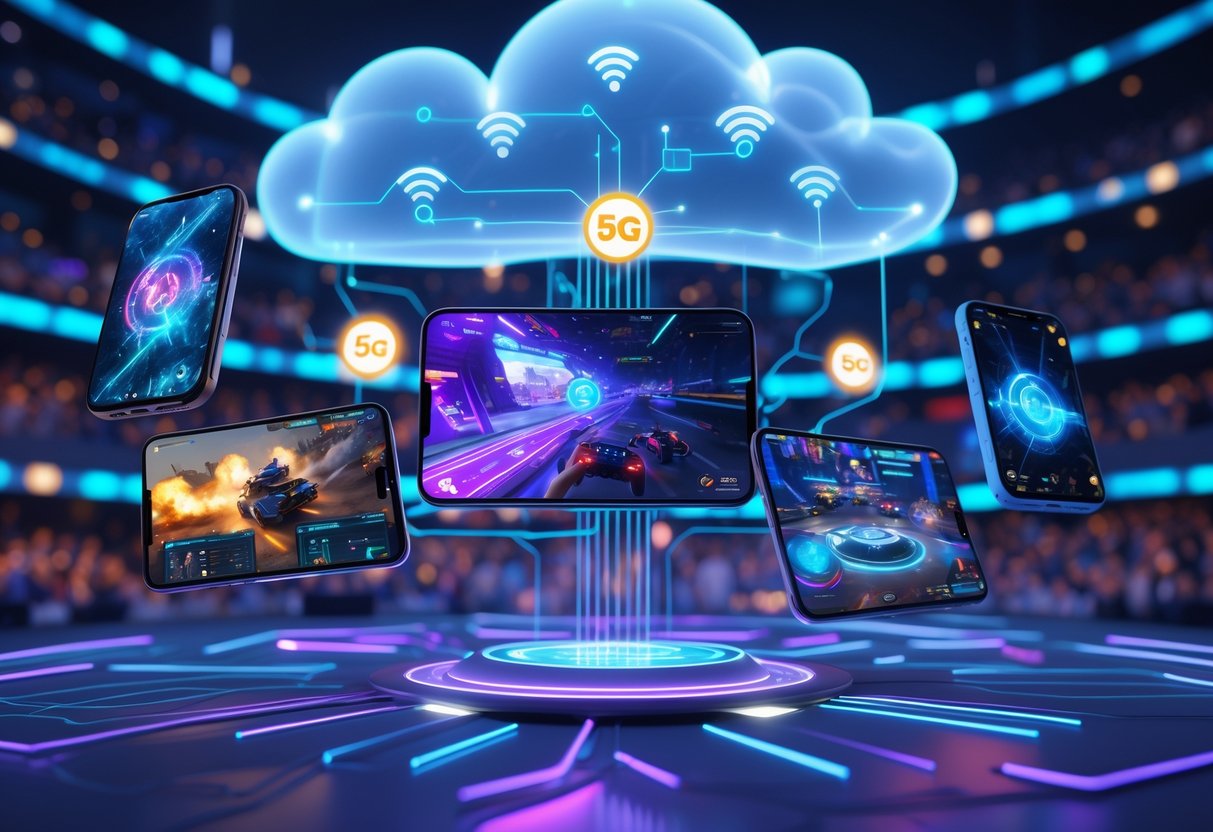
5G’s ultra-low latency and blazing speeds are pushing mobile gaming from casual fun into serious esports competition. Cloud gaming platforms now deliver console-quality play on smartphones, breaking down old hardware barriers.
Opportunities for Mobile Gaming Tournaments
Mobile esports tournaments are blowing up, and 5G is the reason. Games like PUBG Mobile offered £4.3 million in prizes last year.
The numbers are wild. In Asia, mobile esports viewership now beats out traditional PC tournaments. Honor of Kings events pull over 50 million concurrent viewers.
Key growth drivers:
- Latency drops from 100ms to under 20ms for competitive play
- Consistent 4K streaming on mobile
- No expensive hardware needed for tournament entry
Major publishers are taking notice. EA and Activision Blizzard are putting serious resources into mobile-first titles.
Analysts predict mobile competitions will make up over 40% of esports revenue by 2025, up from just 15% a few years ago.
Organisers can now promise pro-level connections for thousands of players at once. That reliability is attracting big sponsors who used to avoid mobile events because of tech worries.
Cloud Gaming: Accessibility for All
Cloud gaming powered by 5G knocks down the biggest barrier to esports: expensive hardware. Now, players can jump into AAA tournament titles using just basic devices.
This technology processes games remotely and streams them instantly. Suddenly, a £200 smartphone can run the same tournaments as a £2,000 gaming rig.
Benefits for tournament growth:
- Larger potential player pools from emerging markets
- Reduced entry costs for amateur competitors
- New subscription-based revenue models for organisers
Microsoft’s Xbox Cloud Gaming and Sony’s PlayStation Now keep expanding mobile offerings for competitive play. Even big telecoms like Verizon offer branded gaming services that use their 5G networks.
The cloud gaming market might top £5.8 billion by 2025. This creates openings for tournament organisers to reach people who couldn’t join before because of hardware costs.
Players in places like Southeast Asia and Latin America now get to join global competitions. Countries with weak broadband are skipping ahead, diving straight into 5G-enabled mobile tournaments.
Immersive Technologies: Virtual and Augmented Reality

5G networks are making virtual reality and augmented reality experiences at tournaments truly possible. These technologies let fans step into virtual arenas or see real-time data overlays during live events.
Virtual Reality Transformations at Events
Virtual reality is changing how we experience tournaments, no matter where we are. With 5G’s ultra-low latency, fans can throw on VR headsets and feel like they’re courtside at major events.
Tournament organisers now offer VR viewing packages for £15-30 per event. You can pick your virtual seat and switch between camera angles in seconds.
The technology shines for:
- Fighting game tournaments where close-up action matters
- Racing competitions with cockpit views
- Football matches with pitch-level perspectives
If you’re curious, try free VR highlights on platforms like Oculus TV before buying full tournament access.
Professional players use VR for training now. Teams practise in virtual versions of tournament venues weeks before competing. This helps them handle stage nerves and boosts performance when it counts.
Many esports venues feature VR spectator zones so attendees can experience different viewing angles or replay key moments. These areas usually charge £5-10 for 15-minute sessions during breaks.
Augmented Reality Overlays and Experiences
Augmented reality gives live tournament viewing a digital upgrade by adding new info to what we see. Modern smartphones and AR glasses show real-time stats, player health bars, and tactical overlays as the action unfolds.
The PGA Championship rolled out “T5G on 14” tech that displays shot analytics and swing data in real time. Now, similar systems pop up at major esports events for games like Counter-Strike and League of Legends.
Popular AR features:
- Player stats floating above competitors
- Damage indicators and cooldown timers
- Interactive replays you control with gestures
- Live betting odds and predictions
Venue operators say fans spend 40% more time in AR-enabled viewing areas. The tech helps newcomers follow complex games by explaining abilities and strategies as they happen.
Heads up: AR experiences can drain your phone battery fast. Venues usually set up charging stations near AR zones.
Tournament apps now include AR mini-games and photo ops. Point your camera at sponsor logos to unlock exclusive content or enter prize draws.
Boosting the In-Stadium Experience
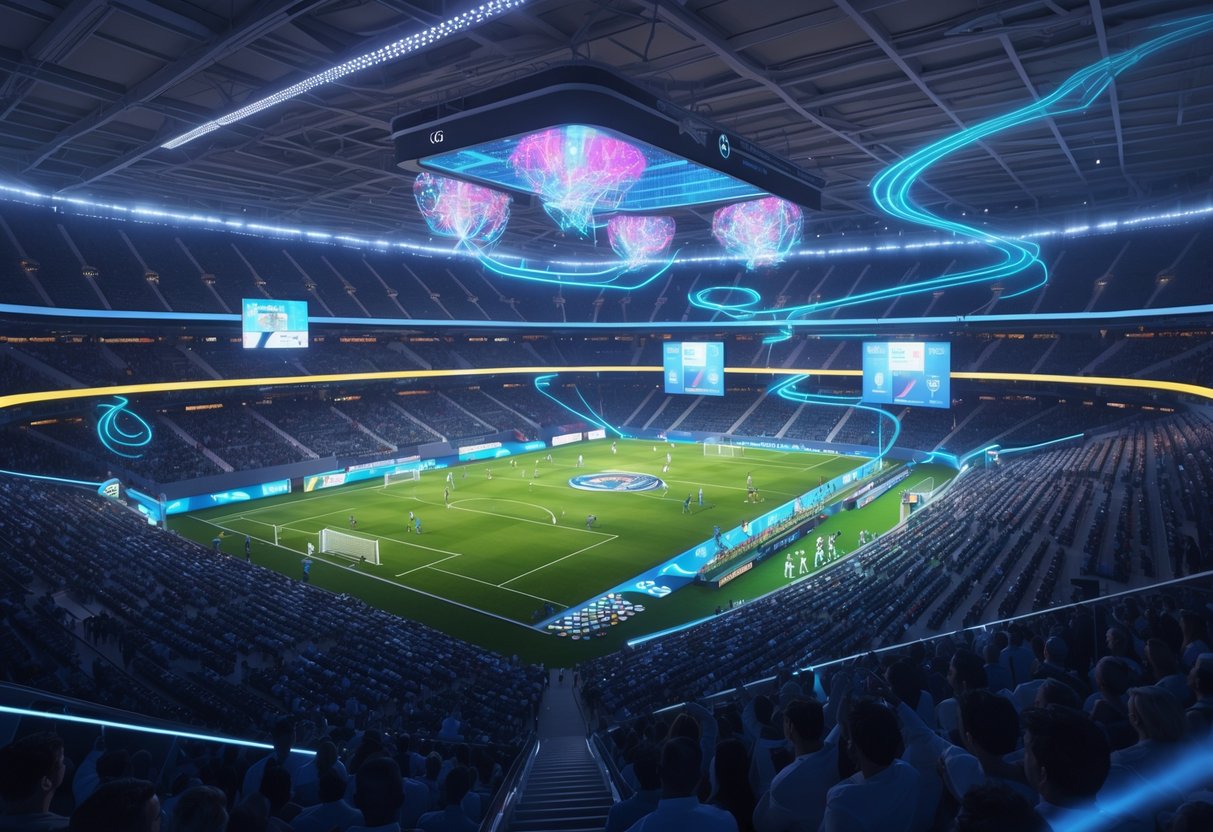
Modern stadiums are turning into high-tech entertainment hubs thanks to 5G. Fans get faster connections, immersive digital services, and can share moments on social media without a hitch.
Smart Stadiums and Connected Venues
5G turns old-school venues into smart stadiums with blazing-fast connectivity. Fans stream high-quality video content without buffering, even when the place is packed.
The tech supports real-time data for live stats, player tracking, and instant replays. Spectators check out multiple camera angles and enhanced viewing options right on their devices.
Private 5G networks handle thousands of connected devices at once. No more dropped calls or slow internet that used to ruin the mood at big events.
Key smart stadium features:
- Ultra-fast mobile internet speeds
- Seamless device connectivity
- Real-time match statistics
- Multiple viewing angles
- Enhanced broadcast quality
Venues now host extra events like esports tournaments, which need reliable, low-latency connections. This brings in new revenue streams beyond just traditional sports.
Personalised Digital Services for Attendees
5G lets organisers create customised fan experiences through mobile apps and connected services. Spectators get personalised content based on where they sit, their team preferences, and viewing history.
Real-time social media sharing is now effortless with 5G. Fans upload high-quality photos and videos instantly—no more waiting for uploads.
Digital ordering systems let people buy food, drinks, and merch without getting up. Mobile payments go through quickly, so queues shrink and everyone’s happier.
| Service | Traditional Stadium | 5G-Enhanced Stadium |
|---|---|---|
| Social media uploads | Slow/fails | Instant sharing |
| Food ordering | Physical queues | Mobile ordering |
| Video streaming | Buffering issues | HD quality |
| Payment processing | Cash/card delays | Contactless speed |
Interactive features include AR overlays showing player stats and game info. We see more engagement when fans can access these personalised digital experiences throughout tournaments.
Real-Time Analytics and Instant Data

5G tech delivers match data to coaches and analysts in milliseconds during live tournaments. Athletes now get instant performance feedback through connected sensors and wearables tracking every move.
Enhanced Coaching Decisions During Live Events
Tournament coaches now get player stats and match data instantly during games. 5G networks process info from cameras, sensors, and tracking systems in under a millisecond.
Real-time interactions between coaching staff and analysts happen through connected headsets and tablets. Coaches get alerts about fatigue, accuracy, and tactics as they develop.
The 2025 PGA Championship showed this off with live shot tracking and player analytics. Coaching teams adjusted strategies between rounds based on fresh performance data.
Key benefits for coaching:
- Instant player performance alerts
- Live tactical pattern recognition
- Real-time opponent analysis
- Immediate injury risk warnings
Lots of pro esports teams now use similar systems at major tournaments. Coaches spot declining reaction times or accuracy drops before players even notice.
Performance Tracking for Athletes
Athletes wear connected sensors that send biometric data continuously during tournaments. 5G tech processes heart rate, speed, and precision metrics instantly.
Wearable devices track muscle tension, hydration, and stress indicators through matches. This helps athletes stay at their best during long tournaments.
Performance metrics delivered instantly:
- Reaction time accuracy
- Physical stress levels
- Focus and attention scores
- Movement efficiency ratings
Tournament organisers use this data to schedule breaks and prevent player burnout. Athletes tweak their strategies mid-match based on real-time feedback about their own trends.
The data even helps spot when players need medical attention before things get serious. Quick tip: Many amateur tournaments now offer simple performance tracking so developing players can understand their strengths and weaknesses.
Monetisation and Marketing Opportunities
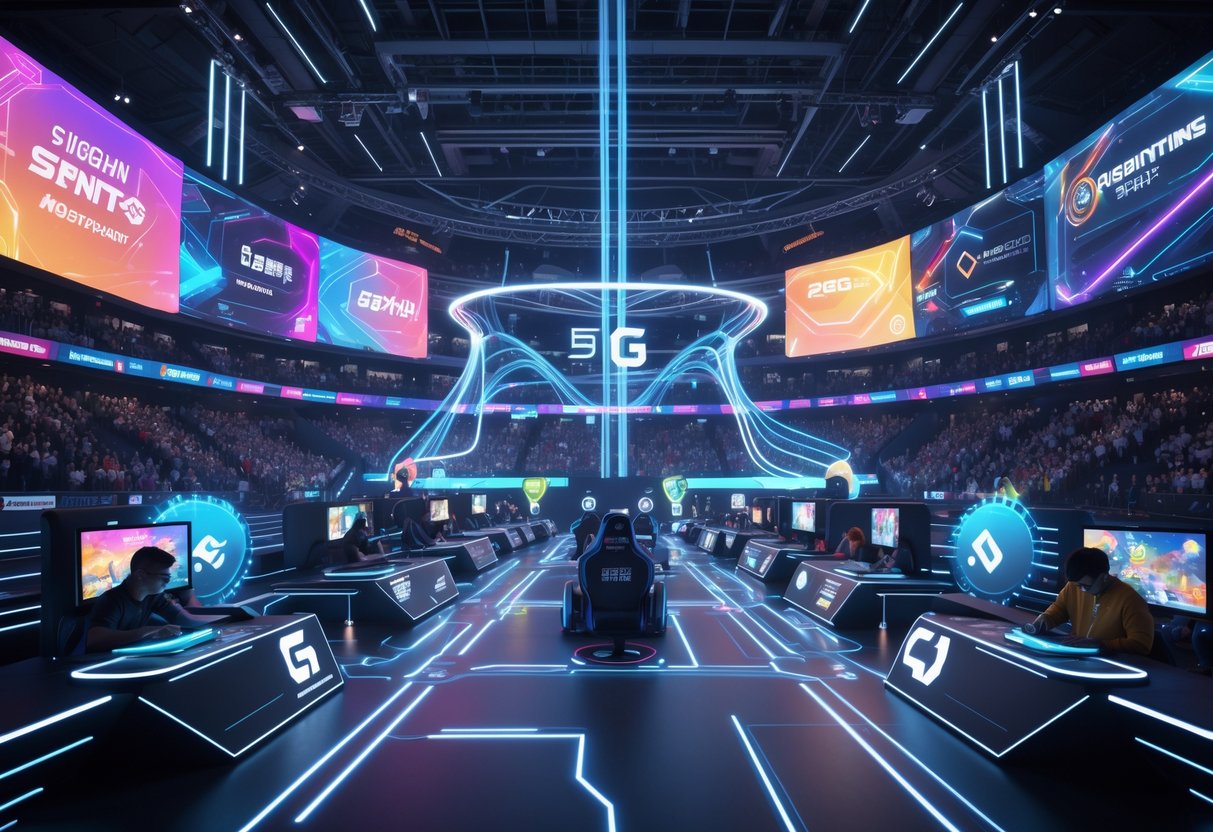
5G networks open up new ways for tournament organisers to make money and reach audiences. These networks enable targeted advertising during live streams and unlock digital revenue streams that just weren’t possible before.
Targeted Promotions and Advertising
5G changes how tournaments deliver ads to viewers. The tech’s speed lets organisers show different ads to different viewers at the same time.
Tournament streams now display personalised ads based on location and preferences. A fan in Manchester might see ads for local gaming cafes, while someone in London gets console deals from nearby shops.
Real-time ad customisation is possible because 5G processes data instantly. Organisers swap ads mid-stream based on what’s happening in-game. If a player uses a certain weapon, viewers might get ads for related gear.
Interactive ads are finally practical with 5G’s low latency. Viewers can tap their phones for discount codes or enter contests without missing the action. These interactive elements boost engagement rates by up to 47% compared to standard ads.
Brand partnerships get more creative with 5G. Sponsors offer augmented reality experiences where viewers point their phones at players to see gear stats or team info overlaid on their screens.
Digital Revenue Streams for Organisers
5G unlocks income sources beyond old-school sponsorships. Tournament organisers can now sell premium viewing packages that just weren’t possible before.
Network slicing creates VIP experiences for paying viewers. Organisers sell “premium lanes” that guarantee flawless stream quality, even when networks are slammed. Fans pay £5-£11 extra each month for guaranteed performance during big matches.
Virtual merchandise sales go up thanks to 5G’s interactive features. Viewers can buy team jerseys or gaming gear right as they see them on streams. The tech processes purchases in milliseconds, so there are fewer abandoned carts.
Multi-angle viewing packages bring in new revenue. 5G lets organisers offer different camera perspectives for small fees. Fans might pay £3 to watch from their favourite player’s view during crucial moments.
Cloud gaming integration means organisers can charge entry fees for mobile-only tournaments that reach global audiences. Players compete directly through their phones—no fancy hardware needed.
Subscription models work better now, too. Organisers offer monthly packages with exclusive content, player interviews, and behind-the-scenes footage, all delivered instantly to mobile devices.
Ensuring Accessibility and Inclusion
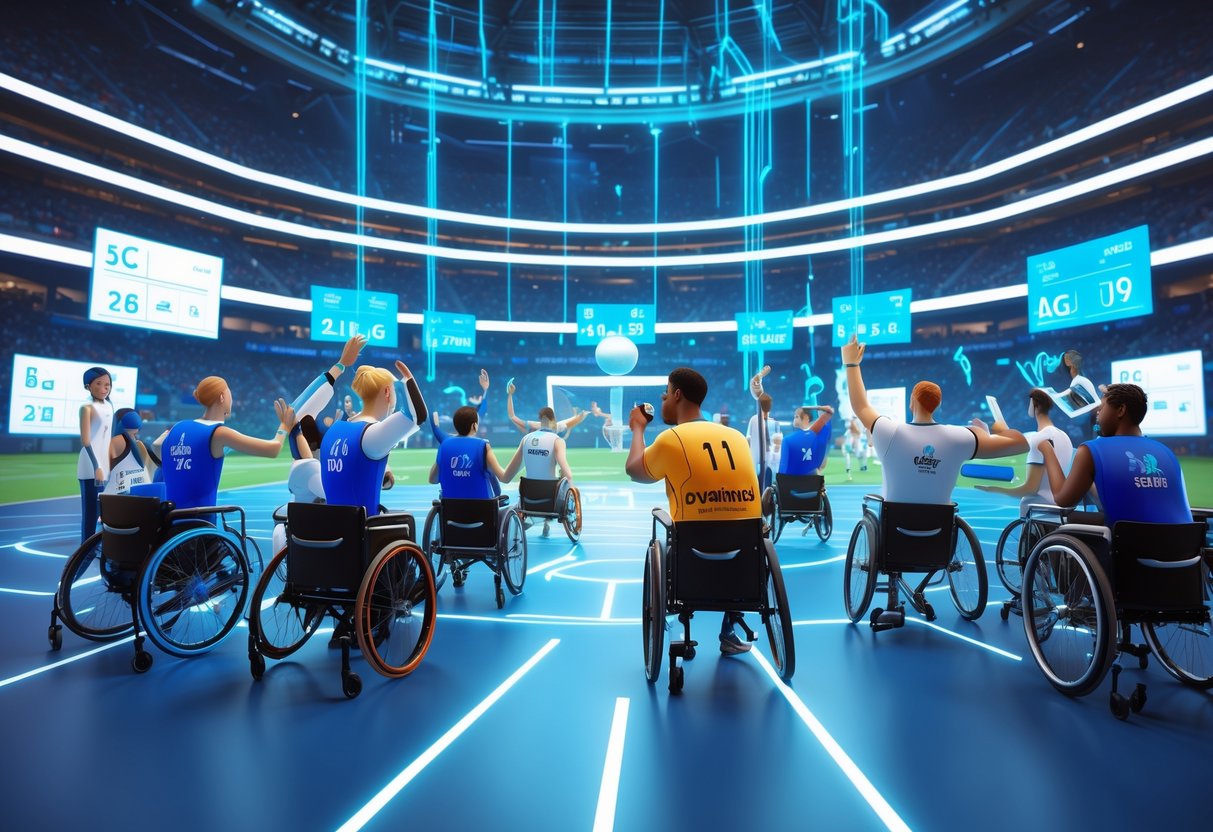
5G networks are tearing down barriers that kept some gamers out of tournaments. The tech reaches remote places and supports new assistive features, making competitive gaming more inclusive.
Expanding Global Tournament Reach
5G networks are connecting players in regions that used to be left out. Remote areas with poor internet now get the high-speed connections they need for competitive gaming.
Tournament organisers can now tap into new talent pools. Players from rural or developing regions aren’t blocked by connectivity issues anymore.
Cloud gaming platforms get a huge boost from 5G. Players don’t need expensive gear when games run on remote servers. A basic device with 5G can handle the same tournaments as a high-end rig.
The tech also supports mobile tournament formats. Organisers host events in places without traditional broadband, opening up venues in smaller cities and emerging markets.
Making Participation Easier with 5G
5G creates new ways for players with disabilities to join tournaments. The tech supports advanced assistive devices that just didn’t work well on old networks.
Visually impaired players now use 5G-powered headsets that give real-time audio descriptions. These devices offer detailed commentary about game actions, so players can follow matches or even play themselves.
The ultra-low latency of 5G makes voice commands and gesture controls super responsive. Players who can’t use traditional controllers rely on alternative input methods without lag getting in the way.
Cloud gaming knocks down hardware barriers for players on tight budgets. Tournament entry is about skill, not equipment. Players compete using shared devices or basic smartphones with 5G.
Mobile accessibility features finally work smoothly with 5G’s steady connections. Screen readers, magnification tools, and custom control schemes all perform better during competitive play.
Future Outlook for 5G in Tournaments
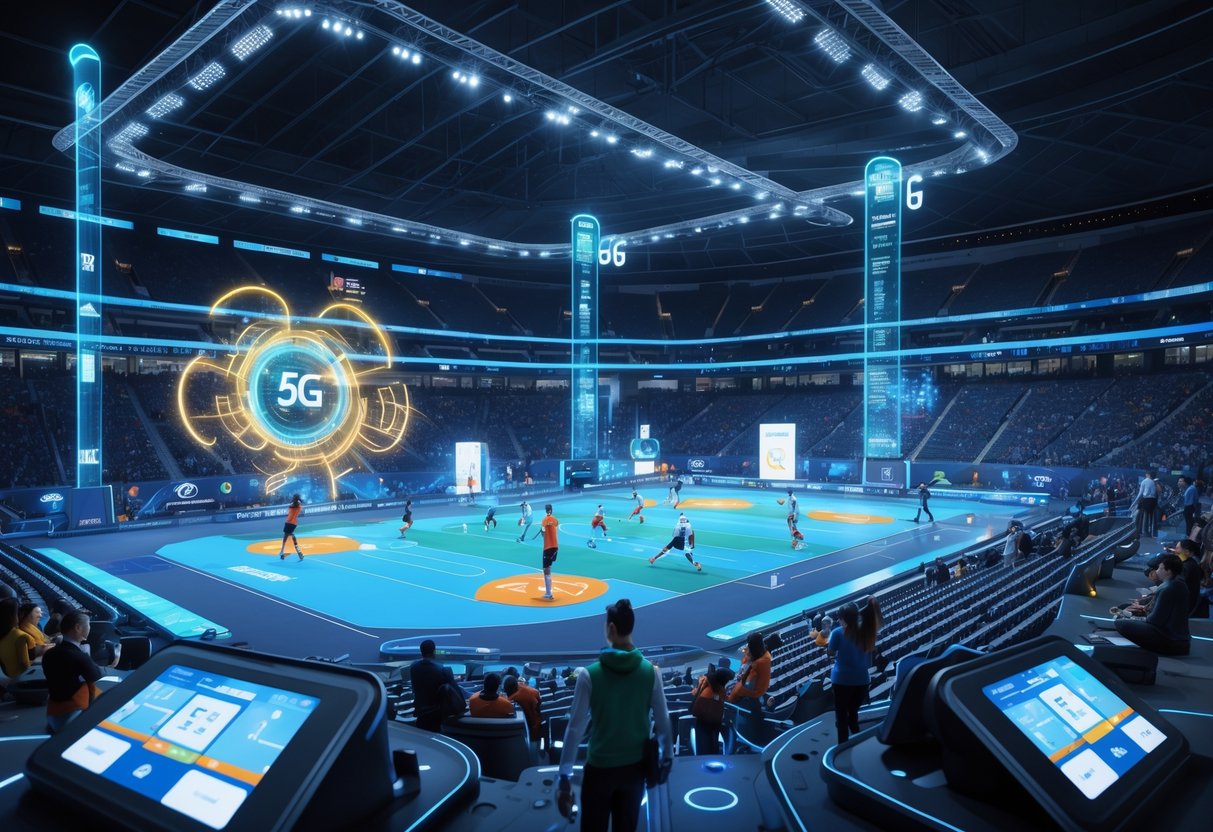
The next wave of 5G innovations is about to shake up tournament infrastructure and open up wild new experiences for fans and competitors.
Organisers are gearing up for tech that blurs the line between physical and digital events, while also meeting the growing demand for more personalised, interactive content.
Anticipated Innovations in Event Technology
5G lets tournament organisers roll out changes in how they run and deliver events.
With network slicing, organisers can guarantee professional-grade connections for thousands of players at once, and even offer different service tiers depending on your participant level.
Cloud gaming platforms powered by 5G get rid of hardware limitations.
We’ll start seeing tournaments where competitors just use basic devices, while all the heavy lifting happens in the cloud.
That levels the playing field and opens the door to new markets where expensive gaming rigs are out of reach.
Key technological advances include:
- Latency down to microseconds on experimental networks
- Edge computing that puts processing right near the venue
- AI-powered, real-time analysis and coaching
- Virtual and augmented reality tournament formats
Mobile tournaments are catching up to traditional PC competitions in both prize pools and viewership.
With 5G, console-quality gaming on smartphones is finally here, and it looks like mobile esports could make up over 40% of tournament revenue by 2025.
Tournament infrastructure is about to get way more flexible.
Organisers can set up pro-quality events anywhere there’s 5G, so there’s no need for dedicated venues packed with expensive networking gear.
Evolving Expectations for Fans and Competitors
Fans want to feel like they’re in the game, not just watching a stream.
5G-powered broadcasts will give us multiple camera angles, real-time stat overlays, and even AR features that show off player strategies as they happen.
Fan experience improvements will include:
- Interactive betting and prediction tools
- Virtual item previews popping up during live matches
- Multi-perspective viewing you can switch on the fly
- Social features that connect fans worldwide in real time
Competitors expect flawless performance, no matter where they play.
With network slicing, organisers can create premium “fast lanes” for high-stakes matches, so even players at home get the same network perks as those in gaming centres.
We’re probably going to see new competitive formats built just for 5G.
Mixed reality tournaments—where physical and virtual elements collide—will put on a show you just can’t get with today’s tech.
Global competitions will run at the same time across continents, all perfectly in sync.
Training and coaching are about to change, too.
Real-time AI analysis, powered by 5G’s speed, lets coaches give instant feedback during practice, and advanced analytics will highlight areas for improvement right after each round.
Soon, the line between amateur and pro tournaments will blur as 5G gives everyone access to top-tier competitive infrastructure, no matter where they live.
Frequently Asked Questions
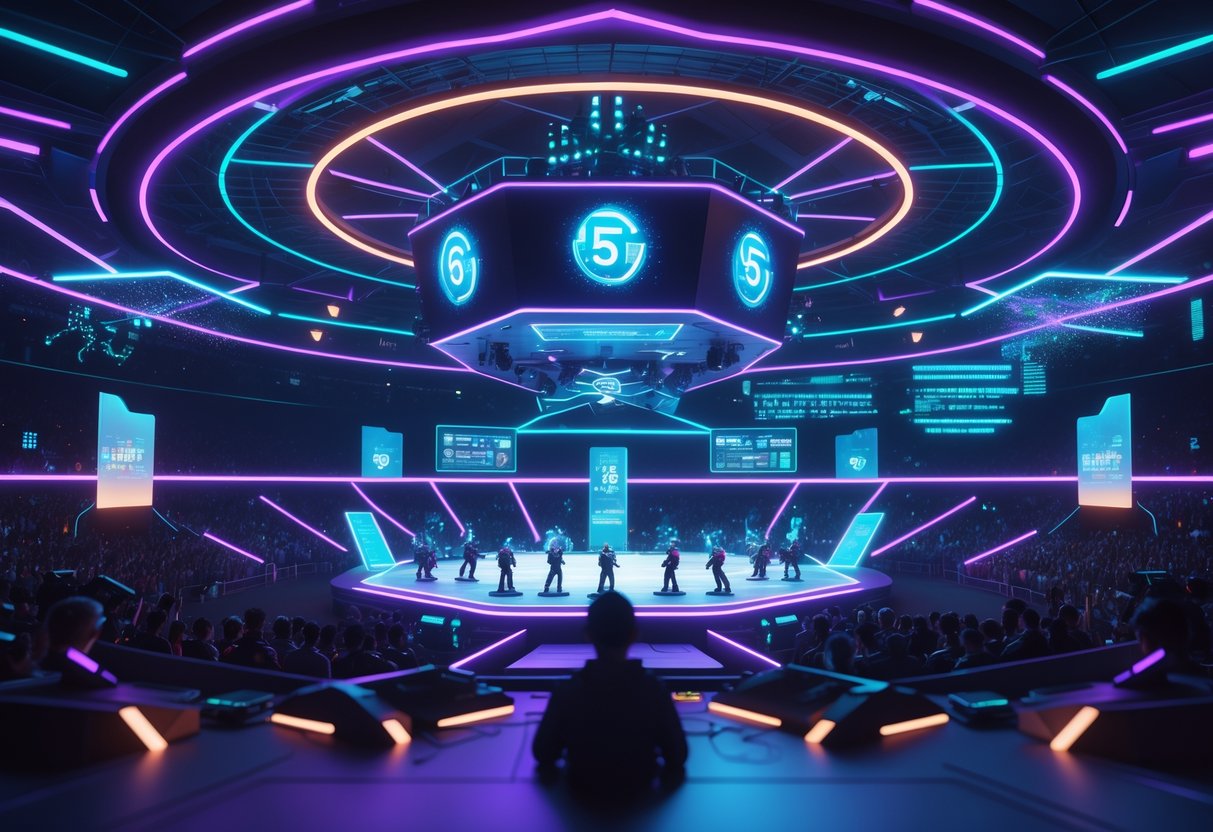
5G is turning tournaments on their head with faster broadcasts, immersive AR/VR experiences, and way better connectivity for both fans and players.
These changes touch everything from real-time data analytics to how organisers handle crowd safety.
How is 5G technology enhancing the viewing experience for live tournament broadcasts?
5G is changing how we watch tournaments.
Now, we get multiple camera angles and live stats right on our phones.
You can zoom in on your favourite player, replay moments in slow motion, and see data overlays while the match is happening.
With 5G, your mobile device basically becomes a mini broadcasting studio.
Viewers can pick their own angles and tap into pro-level commentary tracks.
Live streaming platforms say they see 47% higher engagement with 5G broadcasts.
People are sticking around for 23 minutes longer per session when they get interactive features.
Virtual item purchases during live streams have shot up by 156%.
Turns out, when you can instantly preview cosmetic items on your favourite player’s character, you’re way more likely to buy.
In what ways are 5G networks transforming the capacity for augmented and virtual reality in sports tournaments?
5G makes AR overlays possible, showing player stats, team strategies, and predictive analytics in real time.
Companies push out synchronized content within milliseconds of the live action.
VR headsets now deliver immersive tournament experiences without annoying lag.
You can watch from a player’s point of view or “sit” in a virtual stadium with other fans.
The super-low latency of 5G means AR glasses finally make sense at live events.
Fans get instant updates about players, scores, and match stats—no waiting.
Cloud gaming platforms use 5G to stream console-quality gaming to VR headsets, so tournament venues don’t need pricey local hardware anymore.
What improvements have been made to in-stadium connectivity for fans due to 5G?
Stadium networks now keep up with thousands of users at once, no more slowdowns.
5G handles massive crowds, all using mobile apps at the same time.
Fans can order food, merch, and drinks in a flash—payment takes seconds, not minutes.
Social media sharing is smooth and instant.
You can upload high-res photos and videos from your seat, no buffering.
Stadium apps now give real-time navigation and queue info.
Fans get updates about toilet lines, food stand waits, and parking spots on the fly.
Could you share how 5G is influencing the management and operations of large-scale sporting events?
Network slicing gives every event need its own bandwidth channel.
Organisers can guarantee pro-level connections for thousands of players all at once.
Event staff coordinate through real-time communication systems powered by 5G.
Security, medical, and operations teams all stay in sync instantly, even in huge venues.
Tournament brackets and results update right away across every platform.
Score changes and match progressions show up immediately, which is a big step up from the old days.
Broadcast crews can send high-quality footage from anywhere in the arena.
That flexibility means better coverage and more creative camera shots.
How is 5G ensuring the safety and security of tournaments with elevated crowds?
Security systems tap into 5G to process crowd monitoring data instantly.
Cameras and sensors spot potential safety issues and ping staff within milliseconds.
Emergency comms run on dedicated 5G slices, so they stay stable even if the public network gets slammed.
Crowd flow management reacts in real time to stop bottlenecks before they start.
Digital signs can point fans to less crowded spots right away.
Medical teams get immediate alerts about incidents anywhere in the venue.
First responders access patient info and coordinate treatment faster than ever.
What advancements are there in real-time data analytics for players and coaches thanks to 5G?
Coaches now get live performance data about their players during matches. Heart rate, reaction times, and movement patterns just pop up on tablets right away.
Player stats update nonstop as tournaments go on. You can actually track things like accuracy, damage dealt, and even strategic choices in real time.
Teams rely on 5G for voice channels that don’t lag. Players can hear tactical calls from coaches instantly—no annoying delays that mess up their game.
Training data from practice sessions syncs to the cloud the moment it’s recorded. Coaches can look at player progress and tweak strategies between rounds.

